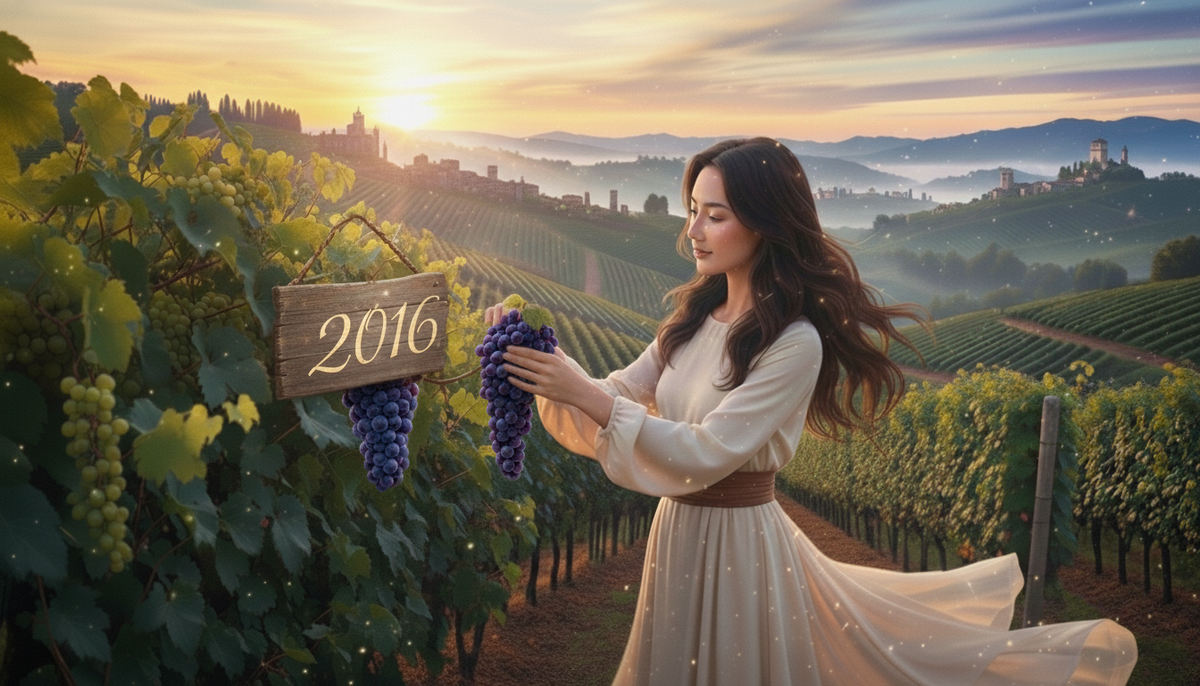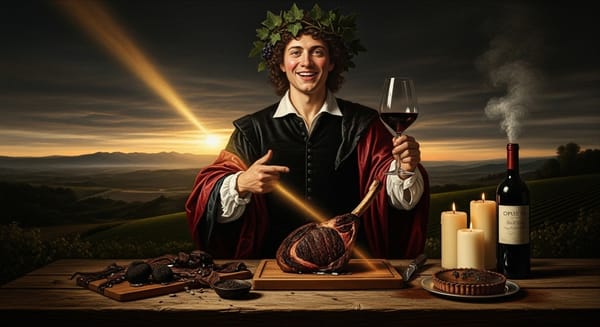2016 Barolo: A Year of Perfect Length That Captured Eternity in the Glass
The 2016 Barolo vintage is a benchmark classic. A long, cool growing season yielded Nebbiolo with stunning balance, high acidity, and firm, integrated tannins. Expect wines of power, perfume, and structure, comparable to 2010. A mandatory cellar vintage with immense longevity to 2055+.

Rose-gold dawn on iron-dark vines—tell me, traveler, have you ever tasted lightning frozen in time?
The Season's Quiet Alchemy: Snowmelt to Electric Night
The Barolo 2016 vintage began with a late-season winter recharge (Feb–Mar), which topped up water reserves after a milder early winter. This blessing ensured the deep soils were nourished for the journey ahead. A cool, unhurried spring followed, the season unfolding with the slow certainty of a drawn breath, leading to an even flowering across most sites. Summer was a period of grace, temperate and steady, without the scorching breath that rushes the vine. The vintage's soul was forged in a long, luminous autumn: September and October delivered golden days for ripening, perfectly balanced by cool September–October nights that preserved the Nebbiolo's vital, crystalline freshness. The harvest was a peaceful ceremony, predominantly mid- to late-October (some sites later). The sky delivered the answer: achieving full dark ripeness with a thrilling acid line, creating perfume with grip.
The Structure's Pledge: Long Life Chiseled in Stone
Is 2016 Barolo worth aging? Unequivocally yes. This vintage stands among the titans of the modern age, often compared to 2010/2004 among modern classics. It marries the chiseled detail of 2010 with the compelling depth of 2004. The wines vibrate with a vivid acidity—a live current—and a structure built from abundant, powder-fine tannin. That slow, extended season and the powerful diurnal swing resulted in a low natural pH (high acidity), driving the vintage’s high-definition focus and site transparency. This rare, almost impossible equilibrium of concentration and coolness is the fuel. It ensures the wines will age gracefully for decades, offering a profound, silent narrative over time.
Decoding the Glass: Flame, Iron, and the Cool Entry
To taste 2016 is to experience a bell tone held in marble air—a clarity so piercing it seems to stop time, drawing a sharp, singular focus. The color is classic garnet, holding a deep, clear core that captures the very essence of autumn light. The aroma is a soaring, intricate duet: bright, high-toned notes of cool sour cherry, wild red currant, and zesty blood orange ascend from the serious, earthy foundations of crushed rose petals, dark tar, licorice, anise, and a distinct ferrous note of iron filings. On the palate, the entry is immediately limestone-cool, gradually building an imposing, yet perfectly balanced structure. The tannins, derived from the Nebbiolo's phenolic-rich skins and seeds, feel simultaneously precise and ancient, ranging from powder-fine dust to river-pebble firmness, carrying the fruit into an impossibly long mineral finish. Nebbiolo lifts its chin in rose and iron, then speaks in the dialect of tea and stone—a complex, profound language whispered across generations.
The Langhe’s Dialects: Soil, Aspect, and Cru Clarity
The Cru Snapshot of 2016 reveals a spectacular, high-definition map of the vineyards. Serralunga d’Alba, rooted in firm, Serravallian soils (older east-side formations; often called 'Helvetian' in older texts), delivered wines like geological events, marked by an iron thread, dark fruit, and seismic depth, demanding generations of patience. Castiglione Falletto achieved brilliance, presenting a seamless lattice of luminous red fruit and exotic spice over perfectly poised, centered tannin. Monforte d’Alba excelled in expressing high altitude tension, showing dark balsam hints of pine and a profound, savory backbone that promises late peaking. La Morra, rooted in its silty Tortonian matrix, provided lifted perfume and ethereal charm, yet the year's acidity kept a serious, firm line. Barolo (Comune) & Novello offered the archetype: a serene blend of cherry, rose, and cedar, delivering measured weight with liquid elegance. The standout performers of 2016 were Verduno (Monvigliero) and Novello (Ravera), where the season's cool length amplified the signature acidity, forging wines of electric focus and long, graceful arcs.
Cellar Choices: Shaping the Spirit with Time and Wood
The season's near-perfect fruit was a canvas that richly rewarded gentle hands. Winemakers used carefully controlled, relatively cooler ferments (28–30 °C) to preserve perfume. Maceration practices varied widely: traditionalists embraced long infusions (25–60 days) using cappello sommerso—submerged-cap maceration for gentle extraction—to draw out the fine phenolics slowly (some houses go longer depending on style). Modernists focused on clean, focused 10–20 days extractions. Time in wood commonly 24–42 months in large Slavonian botti (DOCG: 38 months total, of which 18 in wood; Riserva 62 months). Small proportions of whole-cluster were used for some; in select crus (e.g., Monvigliero styles) even full whole-cluster was employed for lift. Freshness was the secret weapon, perfectly counterbalancing the ABV of 14.0–15.0% (most 14–14.5%).
The Craftsmanship: Hands That Drew the Line
The best producers of 2016 Barolo navigated the massive potential of the vintage with restraint and clarity, allowing the sheer quality of the Nebbiolo to command the stage.
Icons: Bartolo Mascarello delivered a wine of pure, classical austerity and effortless longevity—a statement in stillness. Rinaldi in his final years, with Marta & Carlotta leading, is an epic of aromatic intensity and spiritual precision. Giacomo Conterno's bottlings showcase the vintage’s seamless concentration and monumental depth. Vietti (Rocche di Castiglione) is a stunning portrait of Castiglione elegance, while Elio Grasso (Gavarini Chiniera / Ginestra Casa Maté) captured immense power with perfect acid balance.
Value Plays: Brovia offered complexity and fine tannin across its cru portfolio, a masterclass in finesse. Oddero's estate wines are classically built, destined for patient cellaring. Massolino delivered powerful, dark-fruited Serralunga structure. Fratelli Alessandria highlighted the captivating aromatic lift of Verduno. G.D. Vajra (Albe/Bricco delle Viole) provided crystalline clarity and immediate grace at every tier.
Wild Cards: Burlotto (Monvigliero) is a masterclass in kaleidoscopic aromatic detail and ethereal finesse. Trediberri provided crystalline La Morra purity and quiet energy. Cavallotto (Bricco Boschis) showed remarkable composure and layered, thoughtful depth. Luigi Baudana (Baudana/Cerretta) delivered stunning, site-specific clarity.
The Slow Unfolding: A Calendar of Revelation
The Barolo 2016 wines, armed with their firm structural foundation and high acidity, have a breathtakingly long evolutionary arc ahead. The windows vary by commune and maceration length.
Early Charm (Now–2032): Approachable communes and shorter macerations. They benefit from a two-hour decant to gently persuade the initial structural resistance to soften and to unleash the deep, slumbering fruit.
Sweet Spot (2033–2055): The sacred window where most cru/comune wines fully integrate. Tannins are completely knit into the wine's fabric, and the primary red fruit evolves into luminous tertiary notes of dried rose, worn leather, dark earth, and a quiet, glowing spice.
Marathon (2056+): The titans from Serralunga and Monforte d’Alba, particularly the long-maceration traditionalists. These monumental wines require only slow-oxygenation before service and will continue to reveal their breathtaking detail into the middle of the century and beyond.
Final Reflection
The 2016 Barolo is a truly monumental vintage—a pure Nebbiolo mirror reflecting the perfect balance of sun and stone. Its pristine structure promises a deep, complex, and seemingly endless journey for those with patience.





